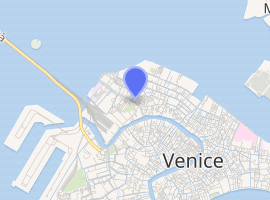Palazzo Nani
Palazzo Nani is a Renaissance palace in the Cannaregio district of Venice, Italy.[1][2][3][4]
| Palazzo Nani | |
|---|---|
.jpg) Palazzo Nani | |

| |
| General information | |
| Type | Office |
| Architectural style | Renaissance |
| Address | Cannaregio district |
| Town or city | Venice |
| Country | Italy |
| Coordinates | 45°26′40″N 12°19′28.4″E |
| Construction started | 16th century |
| Technical details | |
| Floor count | 3 |
History
The palazzo was built in the 16th century to be a residence of the Nani family of the "Cannaregio" branch (later Nani Mocenigo). In the 1680s, the palazzo was remodeled according to a design plan by Alessandro Vittoria, who also performed the interior decoration.[5][6]
In its golden years, the palace kept a substantial art collection, consisting of finds from the Roman era. The entrance portal was decorated with two large statues of consuls.
The Nani owned the palazzo until 1810, when they moved to San Trovaso to live in Palazzo Barbarigo Nani Mocenigo. In 1859, the palazzo was occupied by the Austrian army that converted it into barracks, then it was used as a school.[7] The pieces of the art collection were gradually dispersed.
In 2002, the palazzo underwent an important restoration.
Architecture
Palazzo Nani front facage is of four levels, including a ground floor and a mezzanine. The façade, today rather unadorned, is asymmetrical due to the massive 19th-century additions that extend the whole building to the right. The window layout is pretty regular and includes quadriforas; those of the noble floors have balconies. On each side of the quadrifora on the first floor there is a stone coats of arms.
The interior decoration is also attributed to Vittoria, with stuccoes and frescoes still well-preserved in the portego of the first floor.
The palace was once accompanied by a garden; that area is today built up.
See also
References
- Perl, Henry (1894). "Venezia". Scribner. p. 50. Retrieved 31 July 2019.
- Roeck, Bernd (1991). Arte per l' anima, arte per lo Stato.: Un doge del tardo Quattrocento ed i segni delle immagini (in Italian). Centro Tedesco di Studi Veneziani. p. 5. ISBN 9783799547406. Retrieved 31 July 2019.
- Quadri, Antonio (1821). Otto giorni a Venezia (in Italian). F. Andreola. p. 206. Retrieved 31 July 2019.
- VV, AA (2011). Italia Nostra 436/2008. Quei giganti contro la natura: Associazione Nazionale per la tutela del Patrimonio Storico, Artistico e Naturale della Nazione (in Italian). Gangemi Editore spa. p. 22. ISBN 9788849265118. Retrieved 31 July 2019.
- Palazzo Bonfadini-Vivante (in Italian). AMAV. 1995. p. 13. ISBN 9788877431516. Retrieved 31 July 2019.
- Setton, Kenneth Meyer (1976). The Papacy and the Levant, 1204-1571. American Philosophical Society. p. 21. ISBN 9780871691613. Retrieved 31 July 2019.
Palazzo Nani vittoria.
- Douglas, Hugh A. (2013). Venice on Foot. Read Books Ltd. ISBN 9781447486091. Retrieved 31 July 2019.